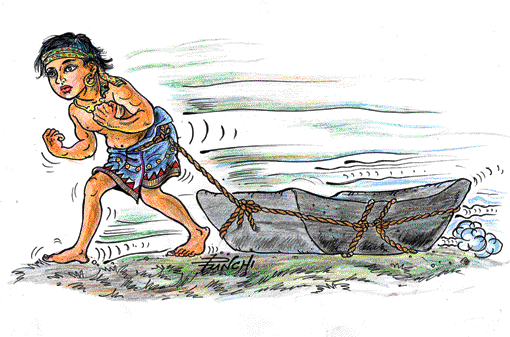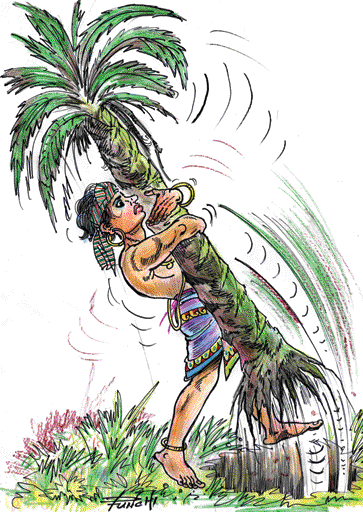Heritage
King Dutugemunu - Part II:
Who were the giant warriors?
Did you read about King Dutugemunu in our last ‘Heritage Splendour’
article? Then you may have realised that the stories behind the life of
King Dutugemunu are quite fascinating. There are many stories related to
his childhood; some of them go back to the time before he was even born.
|

Nandimitta when he was young. |
It is said that Vihara Maha Devi, King Dutugemunu’s mother, had some
weird cravings during her pregnancy; she had wanted to drink the water,
which had been used to wash the sword with which one of King Elara’s
ministers had been killed. This had been considered as a sign, that the
yet unborn child would become a brave, warrior king one day.
As we promised you the other day, today let us tell you about the
giant warriors of the king which is recorded in ancient texts. The first
giant warrior was Nandimitta. He was a nephew of a Sinhalese general in
Elara’s army. Originally named Mitta, he lived in Anuradhapura.
According to legend, young Mitta was always tied to a grinding stone
when his mother went to the well to bring water so that Mitta won’t be
able to follow her out of the house. One day, when his mother was away,
Mitta dragged the heavy stone after him and broke the rope, setting
himself free. Thereafter, he came to be known as ‘Nandimitta’.
Nimala was the youngest son of Samgha. He had six brothers. When the
family got to know that King Kavantissa was looking for warriors for his
army, Nimala’s six brothers decided to send Nimala too and started
making fun of him to prompt him to go. When Nimala decided to join the
army, his parents gave their consent although they didn’t like the idea.
Later, he came to be known as Suranimala.
Tissa, who had eight sons, lived in the village of Hundarivapi. His
youngest son was Sona, who later became known as Maha Sona. According to
legends, it is said that when he was just seven years old, he had the
strength to tear young palms with his bare hands. By the time he was ten
years old, he could uproot palm trees. When King Kavantissa heard about
this boy, he sent his men with gifts to bring the boy to the castle.
Theraputtabhaya was another giant warrior of Dutugemunu’s army. What
was special about this giant was that he was a Buddhist monk, who
disrobed and joined the army. After their victory in the war, he left
the king’s army and re-ordained himself. According to the story, he
became an Arahat.
Bharana was the son of Kumara. At the age of 10 years, he went with
the other boys to hunt rabbits. He was also asked to come and serve the
king.
Gotabhaya was the son of Rohana who lived in a village close to the
Kota mountain. Rohana decided to give up lay life and become a monk.
Gotabhaya was a strong boy who could, as a child, lift huge stones that
normally have required four to five men. The king heard about the boy
and he was also recruited to the army.
In the village of Nitulvita, there was a man named Mahanaga. His
youngest son was Gota, who was a short and lazy boy. One day, his
brothers left home to clear the jungle for cultivation. They worked hard
throughout the day, and left in the evening, leaving a share to be
completed by the youngest brother.
|

Maha Sona could uproot palm trees by the time he was ten years
old |
Hearing this, Gota who felt hurt, went to the jungle and uprooted all
the Imbara trees, preparing the remainder of the field. He went home and
told his brothers that he completed the task. They laughed at him and
went to check what he had really done. They were astonished to see the
work done by their youngest brother!
Thereafter he was known as Gotaimbara. Word about him got around and
he was also recruited to the King’s army.
Vasabha was the son of Matta. He had a well-formed body and was quite
a handsome young man. He was called Labhiya Vasabha. He was very strong
too. When he was 25, he completed work given to him that would normally
take several men to complete. He began building a wewa (tank). He
completed the task within a short period of time and was thereafter
recruited to the Royal Army.
Velusumana was the chief warrior of King Kavantissa. He was the son
of Vasubha, who was respected by the people in his village. On the day
his son was born, his best friends Velu and Sumana came to visit him.
Vasuba named his son Velusumana, combining the names of his two friends.
Velusumana grew up to be the best horseman in the country. He was also
asked to join the army to serve the king.
The 10th giant warrior in the army was Phussadeva. He was famous for
his marksmanship.
These 10 giant warriors helped King Dutugemunu in his battles against
King Elara. In our next ‘Heritage Splendour’ article, we will look into
more details about King Dutugemunu’s life.
-Janani AMARASEKERA |
